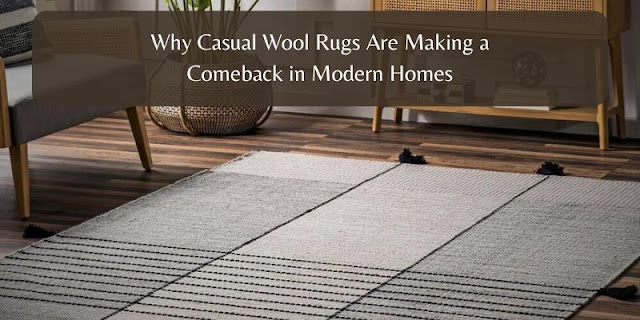Why Casual Wool Rugs Are Making a Comeback in Modern Homes
- Get link
- X
- Other Apps
In today’s fast-paced world, homeowners are leaning towards comfort, simplicity, and understated elegance when it comes to interior design. Amid this shift, wool floor coverings are re-emerging as a stylish and practical choice. These textile pieces, once considered traditional or rustic, are now being embraced in contemporary spaces for their warmth, texture, and eco-friendliness. The subtle aesthetic of casual rugs has become the bridge between modern minimalism and timeless charm, making them a favorite among designers and everyday decorators alike.
One of the key reasons behind this resurgence is the natural material used. Wool is a durable, sustainable, and biodegradable fiber that supports a greener lifestyle. As consumers grow more conscious about the environmental impact of their purchases, choosing home accessories made from renewable resources has gained significant traction. Wool also offers impressive insulation properties, helping to maintain indoor temperature and reduce energy costs during cooler months.
Modern homes often feature open floor plans with neutral palettes, sleek furniture, and clean lines. In such settings, a wool floor covering adds much-needed texture and visual depth. The soft fibers bring a tactile element to the room, breaking the monotony of hard surfaces like tiles or hardwood. They not only soften the overall look but also create a cozy, welcoming environment, which is especially valued in living areas and bedrooms.
Another factor contributing to the renewed interest in these textile pieces is their versatility in design. They come in a range of patterns, weaves, and colors—many of which complement both traditional and contemporary décor. From subtle geometric prints to muted stripes and hand-woven textures, there's a style to suit virtually any interior theme. This adaptability allows homeowners to update their spaces without a complete overhaul, simply by layering in a thoughtfully chosen wool accent.
Comfort plays a significant role as well. Wool’s natural crimp makes it soft underfoot, offering a plush experience without the synthetic feel of many mass-produced options. This makes it ideal for homes with children, pets, or anyone who prefers a touch of luxury beneath their feet. Plus, its ability to resist matting and recover from compression ensures it retains its shape and volume over time, even in high-traffic zones.
Acoustic benefits are another often-overlooked advantage. Open layouts and hard surfaces tend to amplify noise, leading to echo and reduced acoustic comfort. A wool layer helps absorb sound, creating a quieter, more peaceful atmosphere. This is especially beneficial in urban apartments or homes with shared spaces where noise control is essential.
Maintenance has long been considered a downside of wool, but today’s production techniques and protective treatments have significantly improved their performance. Many modern options are stain-resistant and easier to clean than their older counterparts. With simple care routines like regular vacuuming and spot cleaning, these textiles can maintain their appearance and function for many years.
Cultural influence is also driving this trend. Scandinavian and Japanese design philosophies, known for their emphasis on natural materials and cozy aesthetics, have heavily inspired global interiors. These styles often incorporate wool floor pieces as integral design elements, emphasizing comfort and simplicity. As such, more homeowners are following suit by adding these soft accents to create serene and inviting living spaces.
The tactile and visual qualities of wool floor decor also make them a valuable tool in layering—an interior design technique that involves combining textures and elements to add complexity and warmth. By pairing a wool piece with throw pillows, blankets, or wooden furnishings, designers create a balanced look that feels curated yet lived-in.
For those who enjoy seasonal decorating, wool options provide a quick and impactful way to transition a room. In cooler months, a thick, neutral-toned textile can instantly add a sense of warmth, while in summer, a lighter, low-pile version can keep the ambiance breezy and relaxed. This flexibility makes them a year-round essential for evolving home styles.
In conclusion, the revival of casual rugs in modern interiors is more than a fleeting trend—it reflects a deeper shift toward mindful living, functional beauty, and sustainable choices. With their blend of comfort, durability, and aesthetic appeal, these wool creations are redefining home décor for today’s discerning homeowner. Whether used to ground a space, soften an area, or simply enhance a room’s personality, they are proving to be both stylish and smart investments for the modern age.
- Get link
- X
- Other Apps




Comments
Post a Comment